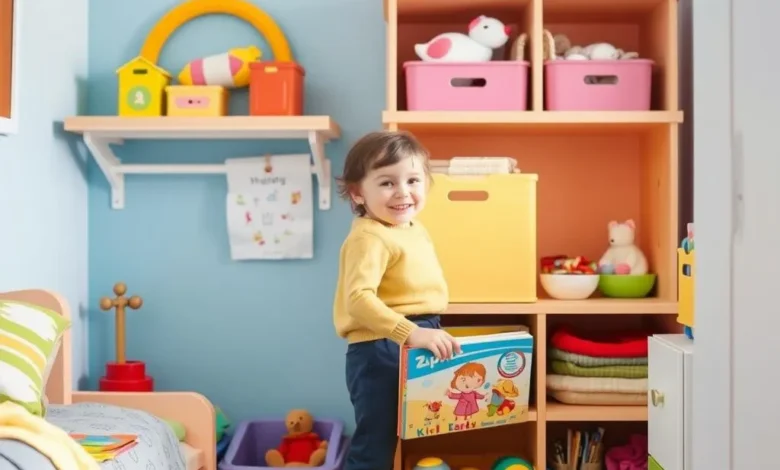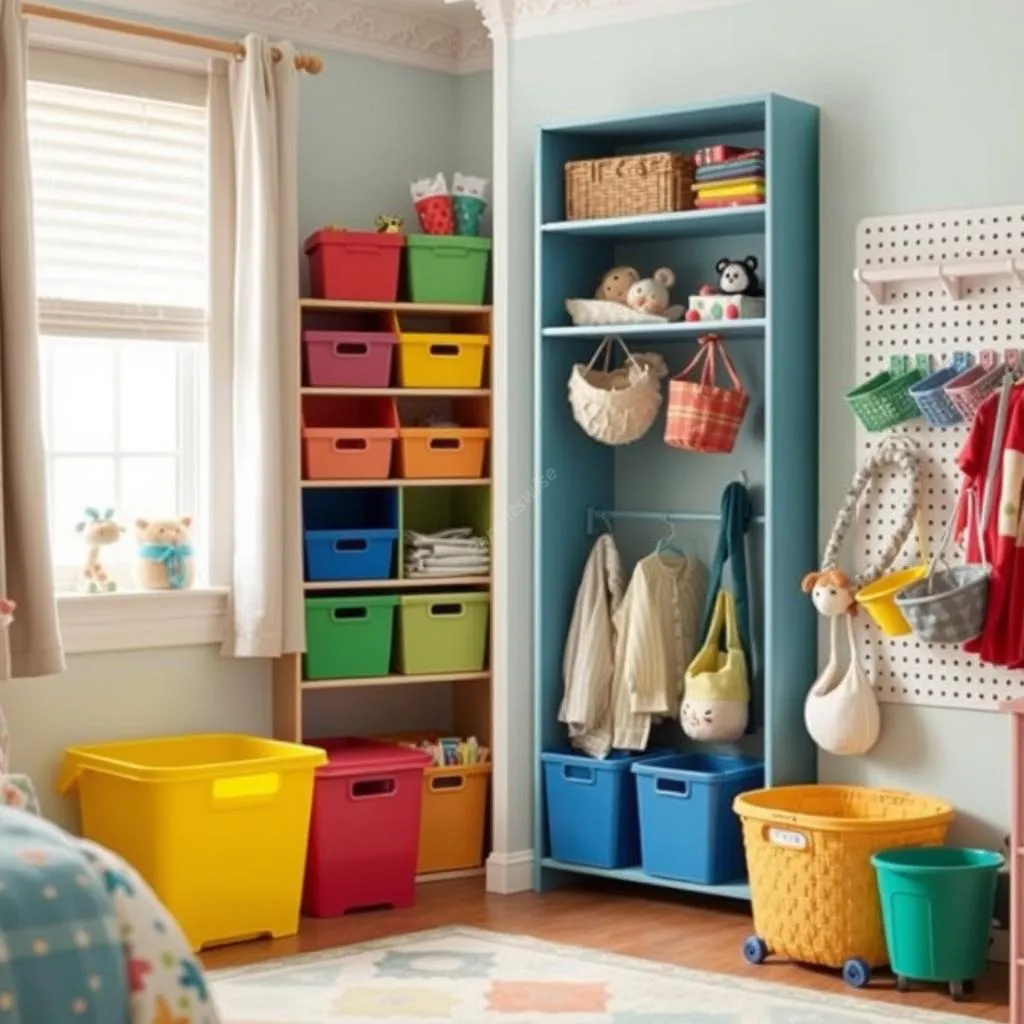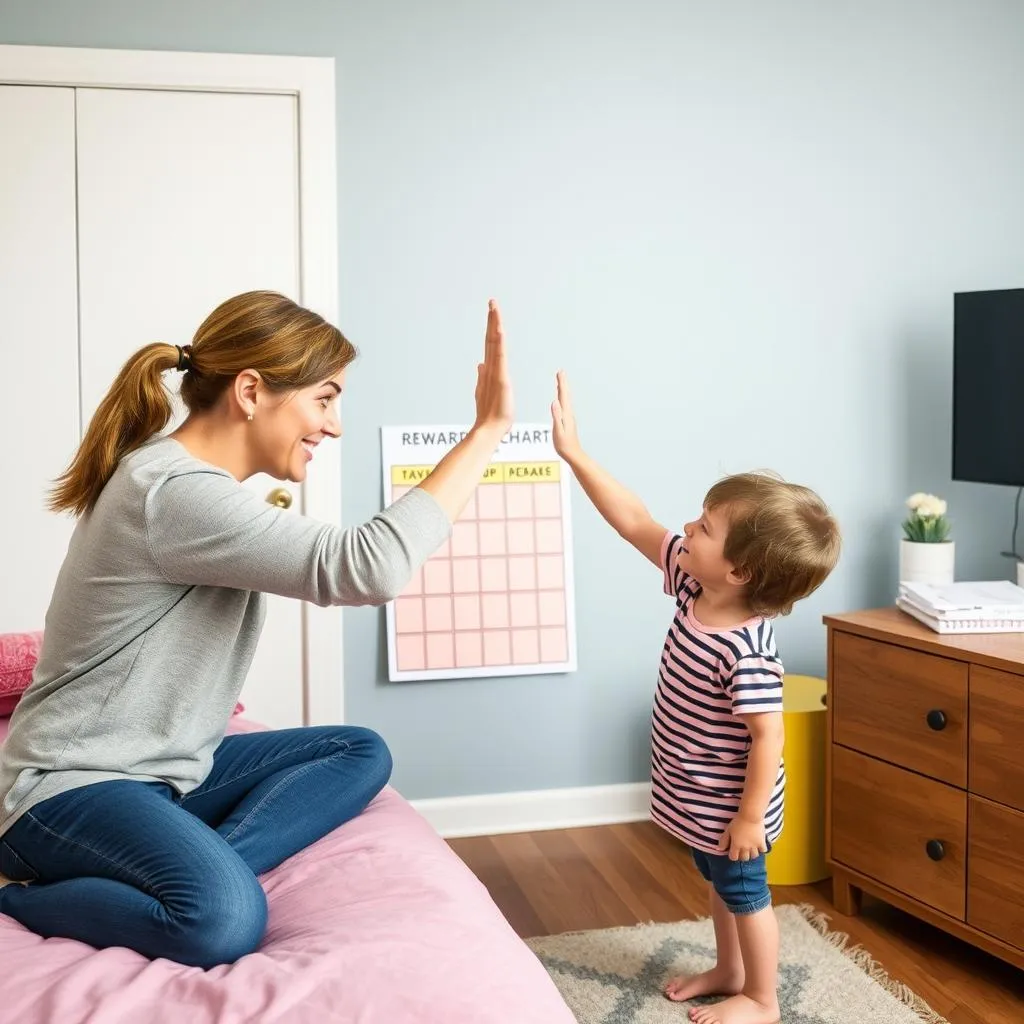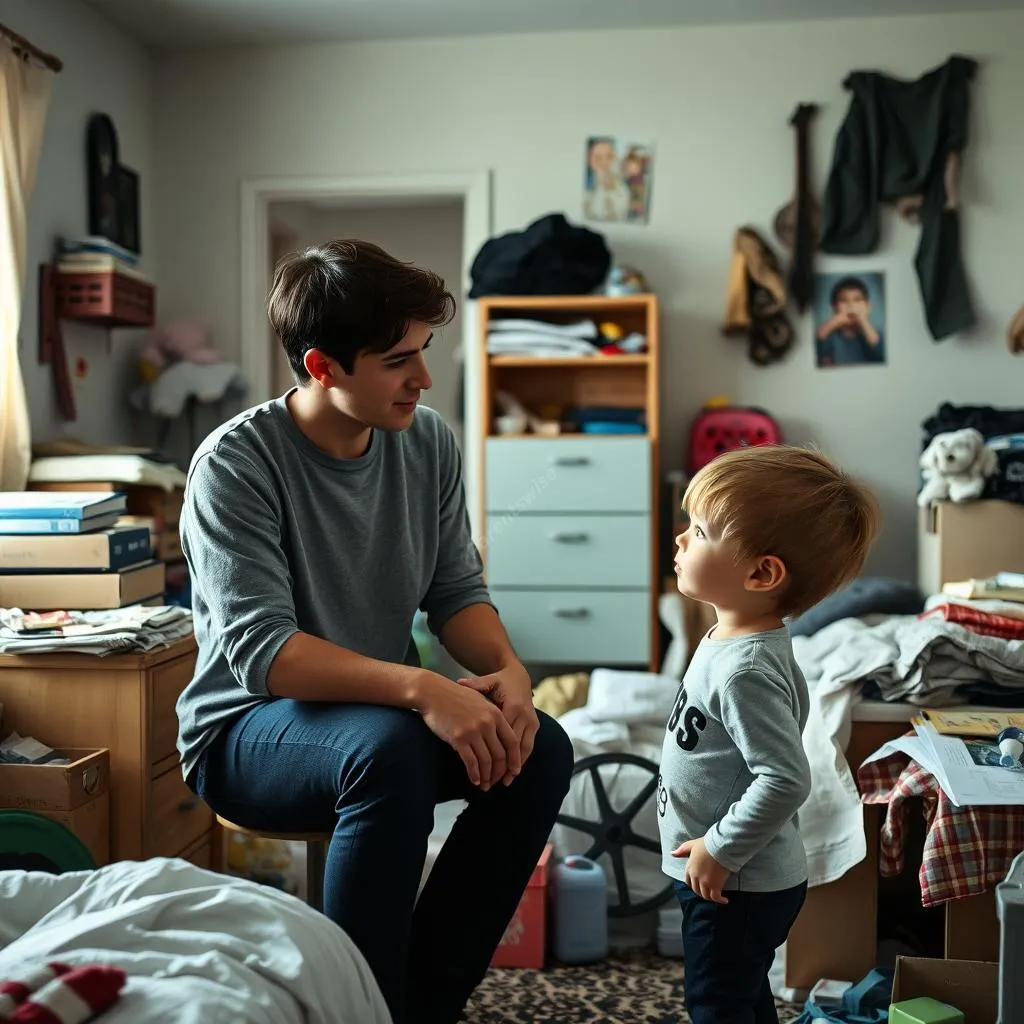How to Motivate Kids to Keep Their Rooms Tidy?

I. Introduction
Did you know that a tidy room can boost a child’s creativity by up to 30%? It’s true! As parents, we often find ourselves in a constant battle with our kids’ messy rooms. But fear not, because teaching children tidiness and organization isn’t just about keeping a clean house – it’s about equipping them with valuable life skills.
In this guide, we’ll explore effective strategies to motivate your kids to keep their rooms tidy. From age-appropriate tasks to fun organizational systems, we’ve got you covered. Get ready to transform chaos into calm and turn tidying up into an enjoyable family activity!
II. Understanding the Importance of a Tidy Room
A tidy room is more than just a treat for parents’ eyes. It offers significant benefits for both children and the entire family. Let’s explore why keeping a room organized matters so much.
A. Benefits for Children
Improved Focus and Productivity
A clutter-free environment helps children concentrate better on their tasks, whether it’s homework, reading, or creative play. With fewer distractions, kids can channel their energy more effectively into learning and growing.
Better Sleep Hygiene
A tidy room promotes better sleep habits. When a child’s sleeping area is clean and organized, it can help them:
- Fall asleep faster
- Experience more restful sleep
- Wake up feeling refreshed
Reduced Stress and Anxiety
Believe it or not, a messy space can be a source of stress, even for kids. An organized room can help children feel:
- More in control of their environment
- Calmer and more relaxed
- Proud of their personal space
B. Benefits for the Whole Family
Less Conflict Over Cleanliness
When kids learn to keep their rooms tidy, it can significantly reduce family tension. Fewer arguments about cleaning up mean more time for positive interactions and bonding.
More Pleasant Living Environment
A tidy kids’ room contributes to a more harmonious home overall. It creates:
- A welcoming space for family and friends
- A safer environment with fewer tripping hazards
- A sense of pride in the family home
Teaching Responsibility and Life Skills
Encouraging kids to maintain a tidy room helps them develop crucial life skills:
- Time management
- Organization
- Respect for personal belongings and shared spaces
By understanding these benefits, both parents and children can see room tidiness as more than just a chore. It’s an investment in well-being, productivity, and essential life skills.

III. Age-Appropriate Expectations
When it comes to kids room organization, it’s crucial to set realistic expectations based on your child’s age and abilities. Let’s break down what you can reasonably expect from different age groups.
A. Toddlers and Preschoolers (2-5 years)
At this age, children are just beginning to understand the concept of tidiness. Focus on simple tasks they can manage:
- Putting toys in a designated box or basket
- Placing dirty clothes in a hamper
- Helping to make their bed (with assistance)
- Putting books back on a low shelf
Remember, at this stage, the goal is to introduce the idea of tidying rather than expecting perfection. Make it fun and praise their efforts!
B. School-age Children (6-12 years)
As children grow, they can take on more responsibilities. Expand their tidying tasks to include:
- Making their bed independently
- Folding and putting away clean clothes
- Organizing toys and books by category
- Keeping their desk or study area tidy
- Vacuuming or sweeping their room (with supervision for younger kids)
This age group can start to understand the importance of regular cleaning. Encourage them to develop their own organizational systems.
C. Teenagers (13+ years)
Teenagers should be capable of more complex organizational tasks:
- Doing their own laundry (washing, drying, folding, and putting away)
- Deep cleaning their room weekly (dusting, vacuuming, changing sheets)
- Maintaining an organized closet and dresser
- Keeping study materials and personal items well-organized
- Contributing to the cleanliness of shared family spaces
At this stage, focus on teaching tidiness to kids as a life skill. Discuss how organization can benefit their academic and personal lives.
Key Points to Remember:
- Adjust expectations as your child grows and develops
- Be patient and offer guidance when needed
- Celebrate progress, no matter how small
- Lead by example in keeping your own spaces tidy
By setting age-appropriate expectations, you’re not just motivating children to clean – you’re helping them build confidence and independence. Remember, the journey to a tidy room is a process, and every child develops at their own pace.

IV. Creating a Kid-Friendly Organizational System
A well-designed organizational system can make kids room organization much easier and more enjoyable. Let’s explore how to create a system that works for your children.
A. Decluttering Together
Before setting up an organizational system, it’s important to declutter. Here are some tips for involving kids in the process:
- Make it a team effort: Work alongside your child to model good decluttering habits.
- Use the “keep, donate, toss” method: Teach kids to sort items into these categories.
- Set a timer: Turn decluttering into a fun, timed challenge.
- Celebrate progress: Reward your child’s efforts to keep them motivated.
B. Easy Storage Solutions
Implement storage solutions that are accessible and easy for kids to use:
- Low open shelves: Perfect for books and frequently used toys.
- Clear, labeled bins: Help kids see what’s inside and where items belong.
- Under-bed storage: Utilize this space for less frequently used items.
- Door-hanging organizers: Great for small toys, art supplies, or shoes.
- Rotating toy system: Store some toys away and rotate them to keep the room tidy and toys exciting.
- Vertical storage: Use wall space with hooks, pegboards, or hanging baskets.
C. Labeling and Categorizing
Make organization fun and easy to maintain with creative labeling:
- Picture labels: For younger children, use images to show where items belong.
- Color coding: Assign colors to different categories of items.
- Personalized labels: Let kids create and decorate their own labels.
- Dry-erase labels: Allow for easy updating as organizational needs change.
Key Strategies for Success:
- Involve your child in designing their organizational system. This increases their buy-in and makes them more likely to maintain it.
- Keep it simple. The easier the system is to use, the more likely your child will stick with it.
- Be flexible. As your child grows, be ready to adapt the system to their changing needs and interests.
- Make it visually appealing. Choose storage solutions and labels that match your child’s tastes and room decor.
Remember, the goal of creating a kid-friendly organizational system is to make motivating children to clean easier and more enjoyable. By involving them in the process and tailoring the system to their needs, you’re setting them up for long-term success in maintaining a tidy space.

V. Positive Reinforcement Strategies
When it comes to motivating children to clean, positive reinforcement can be a powerful tool. By acknowledging and rewarding their efforts, you can make tidying up a more enjoyable and rewarding experience for your kids.
A. Praise and Encouragement
Verbal recognition goes a long way in reinforcing good habits. Here are effective ways to acknowledge your child’s efforts:
- Be specific: Instead of a general “good job,” say “I’m impressed by how neatly you arranged your books!”
- Focus on effort: Praise the process, not just the result. “You worked really hard on organizing your toys today!”
- Use enthusiastic body language: Smile, give high-fives, or offer hugs to show your appreciation.
- Highlight progress: “I noticed you’ve been keeping your desk tidy all week. That’s fantastic!”
B. Reward Systems
Age-appropriate incentives can provide extra motivation. Here’s a table with suggested rewards for different age groups:
| Age Group | Suggested Rewards |
|---|---|
| 2-5 years | Stickers, extra playtime, choosing a bedtime story |
| 6-12 years | Screen time, choosing a family activity, small treats |
| 13+ years | Later bedtime on weekends, privileges like extra phone time, contribution to a savings goal |
Remember, the goal is to gradually phase out external rewards as tidying becomes a habit.
C. Making Tidying a Game
Turn cleaning into fun activities to make it more engaging:
- “Beat the Clock”: Set a timer and challenge kids to tidy as much as possible before it goes off.
- “Cleaning Scavenger Hunt”: Create a list of items to be put away, and have kids check them off as they go.
- “Sorting Olympics”: Make a game out of who can sort items into the right bins the fastest.
- “Clean and Dance”: Play upbeat music and encourage kids to tidy up while dancing.
Key Points to Remember:
- Be consistent with your praise and rewards to reinforce the habit.
- Tailor your approach to what motivates your individual child.
- Gradually reduce external rewards as tidying becomes more routine.
- Make it a family affair by participating in cleaning games together.
By implementing these positive reinforcement strategies, you’re not just teaching tidiness to kids – you’re helping them associate cleaning with positive feelings and experiences. This can lead to long-term habits that will serve them well into adulthood.

VI. Establishing Routines
Creating consistent routines is key to maintaining a tidy room and teaching tidiness to kids. By incorporating cleaning into daily and weekly schedules, you can make it a natural part of your child’s life.
A. Daily Tidy-up Time
Implementing a daily tidy-up routine can prevent clutter from accumulating. Here are some tips for incorporating cleaning into the daily schedule:
- Set a specific time: Choose a time that works well for your family, such as right before dinner or bedtime.
- Keep it short: Aim for 5-15 minutes, depending on your child’s age and the room’s size.
- Use a visual checklist: Create a simple chart with pictures for younger children to follow.
- Make it a family activity: Have everyone tidy their spaces at the same time to foster a sense of teamwork.
B. Weekly Deep Clean
In addition to daily tidy-ups, a weekly deeper clean can help maintain a more organized space. Here’s how to approach it:
Involving the Whole Family
Make the weekly clean a family affair to teach responsibility and teamwork. Here’s an approach you can try:
Set a specific day and time: Choose a day when everyone is usually available, like Saturday morning.
Divide tasks: Assign age-appropriate cleaning tasks to each family member. For example:
- Younger children: Dusting low surfaces, sorting toys
- Older children: Vacuuming, changing bed linens
- Parents: Helping with more complex tasks, supervising
Rotate responsibilities: Switch up the tasks each week to prevent boredom and teach various cleaning skills.
Work together: Start in one room and move through the house as a team, or have each person responsible for their own space.
Make it fun: Play music, have a race to see who can finish first, or tell stories while you work.
Celebrate afterwards: Plan a fun family activity or treat after the cleaning is done as a reward for everyone’s hard work.
Key Strategies for Success:
- Be consistent: Stick to your chosen times as much as possible to establish the habit.
- Start small: If your child is new to routines, begin with just one or two tasks and gradually increase.
- Use visual aids: Create colorful charts or use apps to track cleaning tasks and progress.
- Lead by example: Participate in the routines yourself to show their importance.
- Be flexible: Adjust routines as needed based on your family’s changing schedules and needs.
By establishing these routines, you’re not just motivating children to clean – you’re teaching them valuable life skills about time management and responsibility. Remember, consistency is key, but don’t forget to keep it fun and age-appropriate!

VII. Leading by Example
When it comes to kids room organization and teaching tidiness to kids, one of the most powerful tools in a parent’s arsenal is leading by example. Children often mimic what they see, so demonstrating good organizational habits can have a lasting impact.
A. Keeping Shared Spaces Tidy
The importance of modeling behavior cannot be overstated. When children see parents maintaining cleanliness in shared spaces, they’re more likely to adopt these habits themselves.
Why It Matters:
- It shows consistency between what you say and what you do
- It demonstrates that tidiness is a family value, not just a rule for kids
- It creates a pleasant living environment for everyone
Tips for Success:
- Tidy up common areas regularly, explaining what you’re doing and why
- Involve children in the process of organizing shared spaces
- Show enthusiasm for tidying – attitude is contagious!
B. Involving Kids in Household Organization
Engaging children in family organizing projects not only teaches them valuable skills but also makes them feel like important contributors to the household.
Here are some ideas for family organizing projects:
Seasonal Closet Overhaul:
- Sort through clothes together
- Decide what to keep, donate, or store
- Teach folding and hanging techniques
Pantry or Refrigerator Organization:
- Sort items by category
- Check expiration dates
- Create a system for easy access to healthy snacks
Garage or Storage Area Clean-up:
- Categorize items (sports equipment, tools, etc.)
- Create designated spaces for each category
- Label containers for easy identification
Family Command Center Setup:
- Create a central spot for family schedules, important papers, and messages
- Let kids help design and decorate the area
Key Points to Remember:
- Be patient: Organization skills take time to develop
- Make it age-appropriate: Assign tasks that match your child’s abilities
- Celebrate small victories: Acknowledge improvements, no matter how small
- Keep it positive: Focus on the benefits of organization, not the negatives of messiness
By leading by example and involving kids in household organization, you’re not just motivating children to clean – you’re instilling lifelong habits and values. Remember, the goal is to create a home where tidiness is a natural part of daily life, not a chore to be dreaded.

VIII. Addressing Common Challenges
Even with the best strategies for kids room organization, parents often face resistance and setbacks. Let’s explore how to handle these common challenges effectively.
A. Dealing with Resistance
It’s not uncommon for children to resist tidying up. Here are some strategies for overcoming objections:
- Understand the reason: Is your child overwhelmed, tired, or simply uninterested? Identifying the root cause can help you address it.
- Break tasks into smaller steps: If your child feels overwhelmed, divide the cleaning process into manageable chunks.
- Offer choices: Instead of saying “Clean your room,” ask “Would you like to start with putting away toys or making your bed?”
- Make it relevant: Explain how a tidy room benefits them personally (e.g., finding favorite toys easily, having more space to play).
B. Handling Setbacks
Setbacks are a normal part of developing any habit, including tidiness. Here’s how to stay positive and consistent:
Maintaining a positive attitude and consistency is crucial when facing setbacks in teaching tidiness to kids. Remember that forming habits takes time, and occasional mess-ups are part of the learning process.
- Don’t overreact to mess: If you find your child’s room in disarray, take a deep breath before addressing it. Overreaction can create negative associations with cleaning.
- Use setbacks as teaching moments: Instead of getting upset, use the situation to reinforce organizational skills. Ask, “How can we make it easier to keep things tidy next time?”
- Adjust your approach if needed: If your current system isn’t working, be open to trying new strategies. What works for one child might not work for another.
- Celebrate progress, not perfection: Acknowledge improvements, no matter how small. This encourages children to keep trying.
- Be patient and persistent: Remind yourself that developing good habits takes time. Stay consistent with your expectations and routines.
- Model resilience: If you make a mistake or let things slide, show your child how to bounce back positively.
Key Strategies for Success:
- Communicate openly: Encourage your child to express their feelings about tidying up. Understanding their perspective can help you address concerns more effectively.
- Be flexible but firm: While it’s important to adapt to your child’s needs, maintain consistent expectations about tidiness.
- Focus on progress: Instead of pointing out what’s still messy, highlight what has been accomplished.
- Keep it positive: Frame tidying as a positive activity rather than a punishment or chore.
Remember, the goal of motivating children to clean is not just about having a tidy house, but about teaching valuable life skills. By addressing challenges with patience and understanding, you’re helping your child develop resilience and problem-solving skills along with tidiness habits.

IX. Technology and Apps to Aid Organization
In today’s digital age, technology can be a valuable ally in kids room organization. Let’s explore how various apps and tech tools can support your efforts in motivating children to clean and stay organized.
A. Child-Friendly Organization Apps
There are several apps designed to make tidying fun and engaging for kids. Here’s a brief review of some popular options:
Choremonster
- Age range: 4-12 years
- Features:
- Gamifies chores with monsters and rewards
- Parents can assign tasks and set rewards
- Kids earn points to “level up” their monsters
- Pros: Highly engaging for younger children
- Cons: Some kids may outgrow it quickly
OurHome
- Age range: All ages
- Features:
- Family-wide task management
- Point system with customizable rewards
- Shared family calendar and grocery list
- Pros: Suitable for the whole family, grows with your child
- Cons: May be complex for very young children
Habitica
- Age range: 10 and up
- Features:
- Turns habit-building into a role-playing game
- Users create avatars that level up as tasks are completed
- Can be used for various habits, including tidying
- Pros: Highly motivating for tweens and teens
- Cons: Younger children might find it too complex
B. Using Timers and Reminders
Technology can also support routines and time management. Here are some examples:
- Visual Timer Apps
These apps display time in a visual format, making it easier for younger children to understand. For example, you could set a 10-minute timer for a quick tidy-up session. - Smart Home Devices
Use smart speakers or displays to set reminders for daily tidy-up times. For instance, “Alexa, remind us to tidy up at 7 PM every day.” - Family Calendar Apps
Apps like Google Calendar or Cozi can help schedule regular cleaning times and send reminders to family members’ devices.
Key Points to Remember:
- Choose age-appropriate technology: Ensure the apps or tools you use match your child’s abilities and interests.
- Use technology as a supplement: While apps can be helpful, they shouldn’t replace hands-on teaching and involvement.
- Monitor usage: Ensure that using organizational apps doesn’t lead to excessive screen time.
- Be consistent: Technology is most effective when used regularly as part of your organizational routine.
By incorporating these technological tools into your kids room organization strategy, you can make tidying more engaging and help children develop good habits. Remember, the goal is to use technology to support and enhance your efforts in teaching tidiness to kids, not to replace personal involvement and guidance.

X. Conclusion
As we wrap up our comprehensive guide on kids room organization, let’s recap the key strategies we’ve explored for motivating children to clean and teaching tidiness to kids.
Key Strategies Recap:
- Understand the importance: A tidy room benefits both children and the whole family, promoting focus, reducing stress, and teaching valuable life skills.
- Set age-appropriate expectations: Tailor tidying tasks to your child’s developmental stage, from simple tasks for toddlers to more complex responsibilities for teenagers.
- Create kid-friendly systems: Involve children in decluttering, use easy storage solutions, and make labeling fun and intuitive.
- Use positive reinforcement: Praise efforts, implement reward systems, and turn tidying into enjoyable games.
- Establish routines: Incorporate daily tidy-up times and weekly deep cleans into your family schedule.
- Lead by example: Demonstrate good organizational habits and involve kids in household projects.
- Address challenges patiently: Handle resistance with understanding and view setbacks as learning opportunities.
- Leverage technology: Use child-friendly apps and digital tools to support your organizational efforts.
Remember, patience and consistency are key. Developing tidiness habits takes time, and every child progresses at their own pace. Celebrate small victories and keep the process positive and engaging.
Long-term Benefits:
By investing time and effort in teaching your children to keep their rooms tidy, you’re providing them with:
- Organizational skills that will serve them well in school and future careers
- A sense of responsibility and pride in their personal space
- Time management skills as they learn to incorporate tidying into their routines
- Problem-solving abilities as they figure out effective ways to organize their belongings
- A foundation for independence as they learn to care for their environment
Final Thoughts:
Motivating children to clean their rooms is about more than just maintaining a tidy home. It’s about equipping them with valuable life skills and fostering a sense of responsibility. Remember, the journey to a consistently tidy room may have its ups and downs, but with patience, creativity, and positive reinforcement, you can help your children develop habits that will benefit them for a lifetime.
Stay encouraged, keep it fun, and enjoy watching your children grow into capable, organized individuals!

By continuing to explore and implement various approaches to motivating children to clean, you’re setting your family up for success in maintaining a tidy, harmonious home environment.
